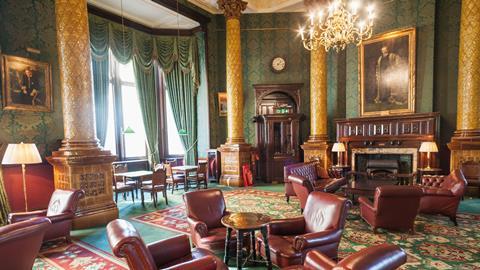I was a member of a London club. So discourse on senior judges’ membership of the all-male Garrick Club has been on my mind. I would not have joined the National Liberal Club (pictured) if it were not ‘co-ed’, though the membership remained decidedly majority-male – my proposer said the male-female ratio was 4:1.
I resigned when the demands of having a severely disabled daughter steered my life away from comfy chairs in Whitehall.
I liked being a member. When I was 21 it was very cheap to join. I could bring friends, and it was a nice space to retreat to when home was a grotty flat.
When the global financial crisis hit, it was also where, as an involuntary freelancer, I went for a desk and the toilets.
None of this helped my career, but I’ve been wondering if it should feed into any thoughts I have about the number of judges who are members of the all-male Garrick Club (or were – some have resigned in the fallout from the Guardian’s investigation).
My first thought is that memberships in a professional context matter. After the bar on women entering the legal professions was lifted in 1919, the spaces, places and memberships associated with the legal profession retained sex-based disqualifying rules.
The Bar Mess at the Old Bailey decided against admitting a woman barrister due to ‘unforeseen difficulties, arising from the nature of the Mess premises’. (I think they meant the toilets being Gents-only.)
Women lawyers fared no better in the regional circuit and sessions messes. As the Solicitors Journal noted in 1922: ‘There are privacies of mess life which render it inconvenient to mix the sexes.’
In light of which, the SJ noted: ‘The general scheme seems to be the admission of women with full rights of membership, but without the right to attend mess.’ Instead, the SJ continued: ‘Women… can form a mess of their own and adopt a Bar hotel of their own in each circuit town… the proposed compromise… seems fair and liberal.’
With the number of women solicitors, and clients and contacts, swelling by the start of the 1960s, more lawyers were running up against arcane rules in the Law Society’s restaurants and bars. Women solicitors could use all of them, but no solicitor, male or female, could entertain a non-lawyer female guest.
Instead of changing the rules, the Society opened the ‘Women’s Annex’ in 1961. Here, in the bar and restaurant (lunch only), women guests could be entertained – hosted by either a male or a female solicitor.
I was going to say the contest on exclusion from spaces continued into the 1980s, when a court case forced wine bar El Vino, popular then as now with lawyers, to allow women access to the bar.
But then we have the Garrick, still going with it in 2024. Two questions arise.
Is the Garrick a professional space? The last time the issue hit the headlines, the point was made that a male junior barrister who’d done particularly well in a complex case might be proposed for the Garrick by the impressed male senior who had led him. That starts to look a little hard-wired into professional progression.
A second point made this time round has been on judicial bias. What mindset do you bring to judicial determinations when, in your private life, your happy place is a discriminatory environment?
Perhaps the Garrick’s judges take what, as a history grad, I’d call the EH Carr defence – we’re all subjective, but as you realise the dangers of your subjectivity, the dangers of bias diminish correspondingly. ‘I’m a member of the all-male Garrick,’ they might think, ‘but I leach self knowledge.’
This defence cannot be completely discounted. Read the Macpherson report on the murder of Stephen Lawrence – it’s decidedly not a product of Macpherson’s background, as some feared it would be when he was appointed. That’s true, but it doesn’t quite put the judiciary or the Garrick in the clear.
If one or two members of the senior judiciary were in the Garrick, and membership of other, more equal and equitable associations predominated, I doubt anyone in the legal world would be discussing this much.
What if more who reached the top were also helping run a community kitchen for folk in need? Solicitor Rachel McKoy, who I interviewed last year, combines work with South Norwood Community Kitchen with heading law and governance at Hounslow Council and leading Lawyers in Local Government. Imagine. She’s a high-flyer, but doesn’t move in an elite echo chamber.
It matters how accessible elite institutions are. It mattered that the old, rich Cambridge colleges went mixed; though by the time we were down to the last couple of male colleges admitting women it mattered less. Would the Garrick going mixed be a bit like Magdalene letting in women in 1988 – just nice to have?
Possibly. But the fact that we’re looking at the over-representation of the judiciary in the Garrick, rather than the less-restricted membership of the Liberal Club, the Reform, or the South Norwood Community Kitchen, makes me think there is a case to be answered by one or two institutions: the judiciary and/or the Garrick.
Of the two, it is the judiciary that most urgently needs to become more diverse. If it were, as far as I’m concerned, the Garrick could keep its single-sex membership.
But as we look at an interconnected nexus of privilege the question is also this: can the judiciary become more diverse without the Garrick changing?
Eduardo Reyes is Gazette features editor



































3 Readers' comments